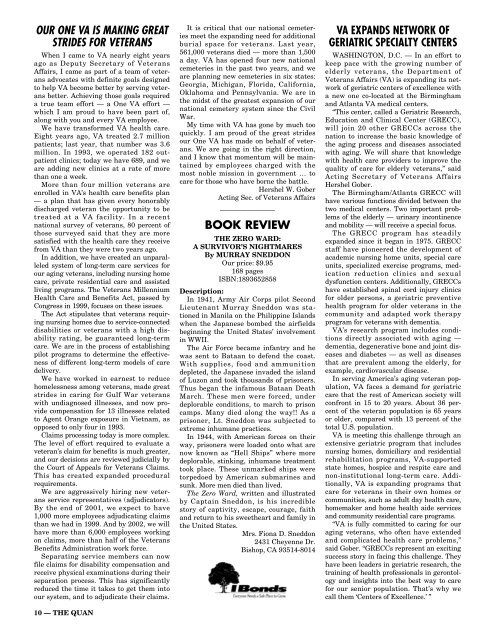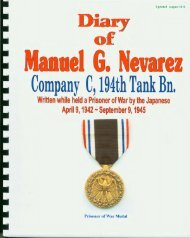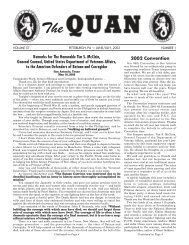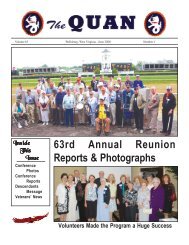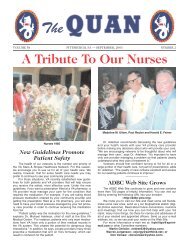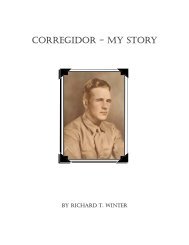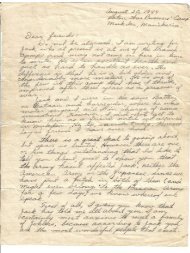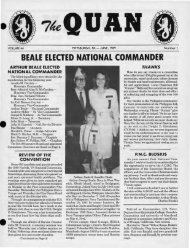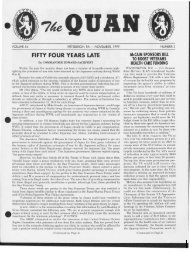Jan. 2001 - Philippine Defenders Main
Jan. 2001 - Philippine Defenders Main
Jan. 2001 - Philippine Defenders Main
Create successful ePaper yourself
Turn your PDF publications into a flip-book with our unique Google optimized e-Paper software.
OUR ONE VA IS MAKING GREAT<br />
STRIDES FOR VETERANS<br />
When I came to VA nearly eight years<br />
ago as Deputy Secretary of Veterans<br />
Affairs, I came as part of a team of veterans<br />
advocates with definite goals designed<br />
to help VA become better by serving veterans<br />
better. Achieving those goals required<br />
a true team effort — a One VA effort —<br />
which I am proud to have been part of,<br />
along with you and every VA employee.<br />
We have transformed VA health care.<br />
Eight years ago, VA treated 2.7 million<br />
patients; last year, that number was 3.6<br />
million. In 1993, we operated 182 out -<br />
patient clinics; today we have 689, and we<br />
are adding new clinics at a rate of more<br />
than one a week.<br />
More than four million veterans are<br />
enrolled in VA’s health care benefits plan<br />
— a plan that has given every honorably<br />
discharged veteran the opportunity to be<br />
treated at a VA facility. In a recent<br />
national survey of veterans, 80 percent of<br />
those surveyed said that they are more<br />
satisfied with the health care they receive<br />
from VA than they were two years ago.<br />
In addition, we have created an unparalleled<br />
system of long-term care services for<br />
our aging veterans, including nursing home<br />
care, private residential care and assisted<br />
living programs. The Veterans Millennium<br />
Health Care and Benefits Act, passed by<br />
Congress in 1999, focuses on these issues.<br />
The Act stipulates that veterans requiring<br />
nursing homes due to service-connected<br />
disabilities or veterans with a high dis -<br />
ability rating, be guaranteed long-term<br />
care. We are in the process of establishing<br />
pilot programs to determine the effectiveness<br />
of different long-term models of care<br />
delivery.<br />
We have worked in earnest to reduce<br />
homelessness among veterans, made great<br />
strides in caring for Gulf War veterans<br />
with undiagnosed illnesses, and now provide<br />
compensation for 13 illnesses related<br />
to Agent Orange exposure in Vietnam, as<br />
opposed to only four in 1993.<br />
Claims processing today is more complex.<br />
The level of effort required to evaluate a<br />
veteran’s claim for benefits is much greater,<br />
and our decisions are reviewed judicially by<br />
the Court of Appeals for Veterans Claims.<br />
This has created expanded procedural<br />
requirements.<br />
We are aggressively hiring new veterans<br />
service representatives (adjudicators).<br />
By the end of <strong>2001</strong>, we expect to have<br />
1,000 more employees adjudicating claims<br />
than we had in 1999. And by 2002, we will<br />
have more than 6,000 employees working<br />
on claims, more than half of the Veterans<br />
Benefits Administration work force.<br />
Separating service members can now<br />
file claims for disability compensation and<br />
receive physical examinations during their<br />
separation process. This has significantly<br />
reduced the time it takes to get them into<br />
our system, and to adjudicate their claims.<br />
10 — THE QUAN<br />
It is critical that our national cemeteries<br />
meet the expanding need for additional<br />
burial space for veterans. Last year,<br />
561,000 veterans died — more than 1,500<br />
a day. VA has opened four new national<br />
cemeteries in the past two years, and we<br />
are planning new cemeteries in six states:<br />
Georgia, Michigan, Florida, California,<br />
Oklahoma and Pennsylvania. We are in<br />
the midst of the greatest expansion of our<br />
national cemetery system since the Civil<br />
War.<br />
My time with VA has gone by much too<br />
quickly. I am proud of the great strides<br />
our One VA has made on behalf of veterans.<br />
We are going in the right direction,<br />
and I know that momentum will be maintained<br />
by employees charged with the<br />
most noble mission in government … to<br />
care for those who have borne the battle.<br />
Hershel W. Gober<br />
Acting Sec. of Veterans Affairs<br />
————————<br />
BOOK REVIEW<br />
THE ZERO WARD:<br />
A SURVIVOR’S NIGHTMARES<br />
By MURRAY SNEDDON<br />
Our price: $9.95<br />
168 pages<br />
ISBN:1893652858<br />
Description:<br />
In 1941, Army Air Corps pilot Second<br />
Lieutenant Murray Sneddon was stationed<br />
in Manila on the <strong>Philippine</strong> Islands<br />
when the Japanese bombed the airfields<br />
beginning the United States’ involvement<br />
in WWII.<br />
The Air Force became infantry and he<br />
was sent to Bataan to defend the coast.<br />
With supplies, food and ammunition<br />
depleted, the Japanese invaded the island<br />
of Luzon and took thousands of prisoners.<br />
Thus began the infamous Bataan Death<br />
March. These men were forced, under<br />
deplorable conditions, to march to prison<br />
camps. Many died along the way!! As a<br />
prisoner, Lt. Sneddon was subjected to<br />
extreme inhumane practices.<br />
In 1944, with American forces on their<br />
way, prisoners were loaded onto what are<br />
now known as “Hell Ships” where more<br />
deplorable, stinking, inhumane treatment<br />
took place. These unmarked ships were<br />
torpedoed by American submarines and<br />
sunk. More men died than lived.<br />
The Zero Ward, written and illustrated<br />
by Captain Sneddon, is his incredible<br />
story of captivity, escape, courage, faith<br />
and return to his sweetheart and family in<br />
the United States.<br />
Mrs. Fiona D. Sneddon<br />
2431 Cheyenne Dr.<br />
Bishop, CA 93514-8014<br />
VA EXPANDS NETWORK OF<br />
GERIATRIC SPECIALTY CENTERS<br />
WASHINGTON, D.C. — In an effort to<br />
keep pace with the growing number of<br />
elderly veterans, the Department of<br />
Veterans Affairs (VA) is expanding its network<br />
of geriatric centers of excellence with<br />
a new one co-located at the Birmingham<br />
and Atlanta VA medical centers.<br />
“This center, called a Geriatric Research,<br />
Education and Clinical Center (GRECC),<br />
will join 20 other GRECCs across the<br />
nation to increase the basic knowledge of<br />
the aging process and diseases associated<br />
with aging. We will share that knowledge<br />
with health care providers to improve the<br />
quality of care for elderly veterans,” said<br />
Acting Secretary of Veterans Affairs<br />
Hershel Gober.<br />
The Birmingham/Atlanta GRECC will<br />
have various functions divided between the<br />
two medical centers. Two important problems<br />
of the elderly — urinary incontinence<br />
and mobility — will receive a special focus.<br />
The GRECC program has steadily<br />
expanded since it began in 1975. GRECC<br />
staff have pioneered the development of<br />
academic nursing home units, special care<br />
units, specialized exercise programs, medication<br />
reduction clinics and sexual<br />
dysfunction centers. Additionally, GRECCs<br />
have established spinal cord injury clinics<br />
for older persons, a geriatric preventive<br />
health program for older veterans in the<br />
community and adapted work therapy<br />
program for veterans with dementia.<br />
VA’s research program includes conditions<br />
directly associated with aging —<br />
dementia, degenerative bone and joint diseases<br />
and diabetes — as well as diseases<br />
that are prevalent among the elderly, for<br />
example, cardiovascular disease.<br />
In serving America’s aging veteran population,<br />
VA faces a demand for geriatric<br />
care that the rest of American society will<br />
confront in 15 to 20 years. About 36 percent<br />
of the veteran population is 65 years<br />
or older, compared with 13 percent of the<br />
total U.S. population.<br />
VA is meeting this challenge through an<br />
extensive geriatric program that includes<br />
nursing homes, domiciliary and residential<br />
rehabilitation programs, VA-supported<br />
state homes, hospice and respite care and<br />
non-institutional long-term care. Addi -<br />
tionally, VA is expanding programs that<br />
care for veterans in their own homes or<br />
communities, such as adult day health care,<br />
homemaker and home health aide services<br />
and community residential care programs.<br />
“VA is fully committed to caring for our<br />
aging veterans, who often have extended<br />
and complicated health care problems,”<br />
said Gober. “GRECCs represent an exciting<br />
success story in facing this challenge. They<br />
have been leaders in geriatric research, the<br />
training of health professionals in gerontology<br />
and insights into the best way to care<br />
for our senior population. That’s why we<br />
call them ‘Centers of Excellence.’ ”


